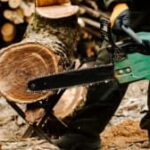As an Amazon Associate, this site earns commissions from qualifying purchases. For more information click here.
Have you noticed lately that your chainsaw blade feels hotter than normal? Maybe you even see some smoke emanating from the blade. Is this normal or should you be worried? In this guide you will learn why chainsaws get hot, why they can sometimes smoke and what you should do. Whether you are a beginner or not, this information is important to avoid potential trouble.
Chainsaw blades get hot during and immediately after cutting wood, but it must never overheat. If the blade smokes or overheats, turn it off and clean the exhaust port and muffler. You may also have to add lubricating oil and adjust the chain.
Why Chainsaw Blades Overheat
It is normal for chainsaws to feel a bit hot. If you let it warm up – and you should – then it should feel a little warm to the touch. But these are not supposed to smoke or go through an engine overheat. Either or both requires immediate attention.
The most likely reasons for an overheating or smoking chainsaw are poor ventilation, lack of oil, or old oil that needs to be replaced. Each of these are covered in detail below.

If you have been cutting wood under the sun, you should expect the blade to get hot. This is normal for any gas powered chainsaw. Even electric and battery powered models get a little warm after prolonged use.
An overheating or smoking chainsaw is another matter. Turn the saw off right away and inspect it closely. Use the following as a guide to find out what is wrong.
Misaligned Chain and Blade
The chainsaw blade and chain have to be aligned properly. The blade width must also match the drive link thickness. The chain or blade will get very hot or smoke if these are misaligned.
If the chain is too tight, the chainsaw will overheat. Do not let the chain droop but keep it loose enough so you can put a quarter in it.
We cannot stress how important it is to have the chain properly installed. If it is too loose the chain could suddenly fly off and put you at risk of injury. If the chain is too tight, it will hamper the cutting movement.
Your chainsaw owner’s manual has more specific instructions on how to align the chains. Use that as a guide. If the teeth is broken, we recommend the Oregon 3-Pack S62 AdvanceCut Chainsaw Chain. It is compatible with 18 inch bars from Echo, Husqvarna, Craftsman, Poulan and more.
Too Much Ethanol
Chainsaw fuel should only have 10% or less ethanol. Anything higher than that and it will overheat the engine.
Check your chainsaw manual and use only the recommended fuel mix. It will either say 10% ethanol or less, and most chainsaws can run without it.
Any 2-stroke or 4-stroke engine can accept ethanol, but too much makes lubrication difficult. The less lubricated the engine is, the harder it has to run which causes overheating.
There are many types of chainsaws but the role lubrication plays is the same.
Engines are made up of many parts, and when it runs, these components interact with each other. The movement generates friction and over time, this is going to wear the components out.
What lubrication does is smooth the process out. Lubricants make it easier for the engine to run and requires less effort. This also means reduced stress for each part. In turn this will prolong the life of your chainsaw.
Little to No Oil Left
One of the most common reasons why chainsaws overheat is lack of oil. Therefore the fuel tank is one of the first places you should look at when this happens.
The oil lubricates the engine and enables the chainsaw to cut smoothly. Without oil, friction increases and forces the engine to exert more force.
The harder the engine runs, the faster it wears out. Heat builds up and eventually smoke appears. Make it a point to regularly check the fuel tank when you do a lot of wood cutting.
Use only the manufacturer recommendations for the fuel preparation. Always follow the instructions from the manual when it comes to using and mixing chainsaw oil and gas.
Dull or Worn Out Chain
Cutting with a dull chain is going to overheat the whole blade. Sharpen it regularly with the Oregon Professional Compact 120-Volt Bench Grinder and you can avoid this. Sharpening works well but over time, it may have to be replaced.
The rule of thumb is to sharpen chains after every three hours of rigorous cutting. But yours may last longer or shorter depending on what you are cutting.
It is easy to tell if the chain is sharp. If you see coarse sawdust, the chain is still usable. However if the sawdust is fine, the chain has dulled.
Sharpening the chain should fix this problem, but at some point it will need a replacement. Knowing what chainsaw chains to use is necessary to avoid performance issues. High quality chains last a long time though, so if your equipment is new you probably will not need a replacement right away.
A Clogged Air Filter
A dirty air filter can cause chainsaws to malfunction, smoke or stop running altogether. Sawdust and other debris can clog the filters and increase friction, affecting performance and stability.
Large and small engines are vulnerable to clogged air filters especially with heavy duty use. If left untreated, the engine will be forced to work harder just to start and cut. This increases the temperature and causes overheating and smoking.
All you need to do is clean the filters. This is pretty easy and should be one of the first things you should examine if there is a problem with the blade.
Why Do Chainsaw Blades Smoke?
A very hot chainsaw blade usually ends up smoking because the issues are the same. This also means you can apply the same fixes.
There are however, other reasons why there is smoke on the chainsaw. If you have ruled out the causes cited earlier, look for the following.
Fuel Problems. If there is enough oil but you see smoke, it is probably due to an issue with the fuel. Turn the tool off before doing any inspection, cleaning or repair.
Clogged with debris. If your fuel tank is not properly sealed, sawdust, wood strands, dirt, leaves, dust and other particles could get into it.
Waterlogged. Gas chainsaws are built for use in wet conditions. But an old or poorly maintained fuel tank is vulnerable to leaks.
Incorrect fuel mix ratio. Your chainsaw comes with specific instructions about the mixture. Using an improper ratio can cause all kinds of issues.
Too much oil. There could also be a copious amount oil or gas in the tank. This will affect the mixture and cause smoke to bellow out. Remove the oil and prepare a new mix.
Old oil. The fuel mix is old and been contaminated by debris. If the oil looks dirty and been sitting in the tank for a long time, replace it.
If the tank is drying out that will also be troublesome. The bottom line is this: inspect the fuel tank before you start using the chainsaw, and it should be the first thing you look at if there is smoke or the blade gets very hot.
Lack of Ventilation
A chainsaw engine needs air circulation to run. Insufficient air flow results in poor performance and smoke. If left unattended the chainsaw will stop functioning at some point.
Shake the air filter a few times to clear the debris. Dip it in water and let the filter dry before putting it back on the chainsaw. If that does not work, you may have to replace the air filter with a new one.
It is a good idea to have a few spare air filters on hand. But a well-designed product will last a long time. Just give a good thorough cleaning and it should work.
Idle Speed is Too Fast
If you see smoke from your idling chainsaw, it means the idle speed has to be slowed down. Turn the slow adjustment speed screw clockwise with a screwdriver. Make adjustments incrementally until the smoke disappears.
The adjustment screw is usually on the right and will have 1-3 screws. Check your manual for details. After making an incremental adjustment, check if there is still smoke. Each tweak has to be minimal and be carefully done.
Clean the air filter first before adjusting the idle speed. Because changing it will affect performance, you should exhaust all other possibilities before trying this one.
How to Prevent Chainsaw Smoking and Overheating
Prevention is the best cure they say, and that applies to chainsaws too. If you are going to cut wet wood for instance LNK it pays to have a clean chainsaw. With regular maintenance you minimize the chances of engine malfunction.
- Clean the starter cover and try to get rid of as much debris and grease as possible.
- Next, use a screwdriver to remove the cover.
- Clean the starter and flywheel. Remove as much dirt as possible.
- Clean the cylinder top the same way you did the starter cover. Check the manual for what screwdriver to use.
- Take off the casing on top of the muffler and clean the interior. You will need to buy and install a new muffler if it is covered with carbon.
Once you are done cleaning, put the covers back on. Replace the fuel if you have not done so already and adjust the chain if necessary. Turn the chainsaw on and give it a test run.

I love the outdoors and all the tools for maintaining gardens, yards and lawns. The only thing I am more passionate about is sharing what I know about garden and outdoor equipment.


